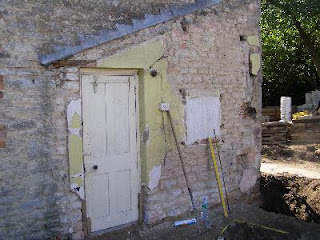Under the latter heading come a few things which still bug me:
- The attitude of the Conservation Officer - this relationship seemed to have gone wrong near the start, but I still don't really know why, other than because (just possibly) the CO really IS an unhelpful person.
- The fact that Highways at the County Council told me that I could not widen the existing gateway to make a single driveway entrance for both houses as it was too close to a junction, but then (after I had made an entrance in the old wall) they allowed my new neighbour to make a new entrance even closer to the junction!
- A newly laid slate has slipped from the roof to the gutter, but the roofer has yet to come and fix it.
- The new kitchen sash window is four over four, not two over two as the rest of the windows.
- There is still no vent to the kitchen...
- Thames Water fitted an external meter in the pavement and this has been found to be a joint supply. Now we have to get an internal meter fitted, but that would have been so much easier if done before the new kitchen was fitted, as I intended.
- My new loft hatch is not quite square, because the joists were not parallel!
- The new extension is not exactly as intended - the roof is higher, the chimney lower and the plasterer gave me incorrect answers to two clear questions, with the result that the internal work I did is not perfect; one window cill has thicker render than he said, so it's almost level with the top of the lower window frame, and a plastered stud wall is thinner than the rendered blocks that it rests on.
- The stone wall where I filled in the bottom of the old doorway
- The wall which I lime-plastered myself (the stone wall which is the join between the old house and new-build extension)
- The new 6' stone wall beside the front door, and the attached gates
- The new sash window which cost just £95 from a reclamation yard
- The front room floor where I replaced bits of joists and re-laid most of the boards plus some reclaimed ones
- The stud wardrobe frontage which I built for the master bedroom
- The wood-burning stove in the kitchen, in the alcove which I "found" by removing the old tiled fireplace
- The recently fitted secondary glazing (we are cosy, and it is quieter now)
- The limecrete/black limestone floor in the kitchen (laid by Chris, Shane and me)
- The black limestone floor in the new extension which I laid entirely by myself (on concrete...)
- The extension roof on which I laid over half the slates in just over a day on my own, much to Chris's surprise
- The casement window in the new extension which I salvaged from the old extension and did a major repair job
- The 1800+ Imperial bricks from the old extension which Jane and I salvaged and were re-used in the new extension (I only had to buy about 200 more)
- All the other little bits and pieces from the old building which I laboriously removed, kept and re-used
- Buying my own mixer, instead of hiring one
- Deciding that I would manage the entire process myself, instead of paying a builder to project manage it



































